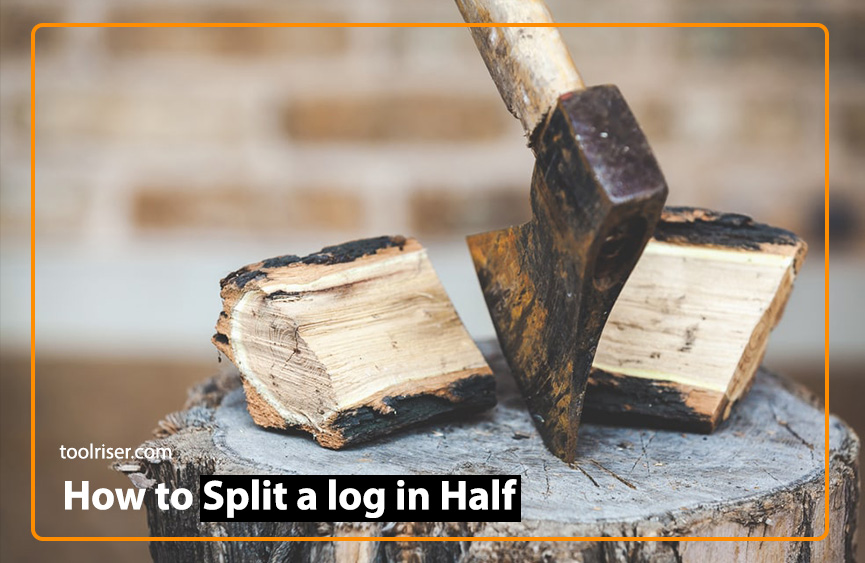How to Split a Log in Half: Step By Step Guide 2024

In the profession of firewood, splitting logs is a fundamental skill. If you’re a seasoned lumberjack or a homeowner with a fireplace, knowing how to split a log in half efficiently can save time and effort. From selecting the right tools to ensuring safety precautions, this guide will walk you through the process step by step.
Splitting logs is the process of breaking down large pieces of wood into smaller, more manageable pieces. This is commonly done for firewood or woodworking purposes. While it may seem straightforward, proper technique and tools are essential for success.
Tools Required for Splitting Logs

Before splitting the log, it’s important to gather the essential tools:
- Log splitter (manual or hydraulic)
- Axe or maul
- Wedges (optional)
- Safety gear (gloves, safety glasses, steel-toed boots)
Safety Precautions Before Splitting Logs
Safety should always be a top priority when working with logs:
- Wear appropriate safety gear to protect yourself from potential injuries.
- Clear the area of any debris or obstacles that could cause tripping hazards.
- Ensure proper footing and balance to prevent falls while swinging tools.
Step-by-Step Guide on How to Split a Log in Half

1. Choosing the Right Log
Start by selecting a log that is straight and free of knots or branches. Green wood tends to split easier than seasoned wood.
2. Preparing the Log
Place the log on a stable surface, such as a sawhorse or chopping block. Position it so that the grain runs vertically, making it easier to split.
3. Using a Log Splitter
If you have access to a log splitter, follow the manufacturer’s instructions for operation. Position the log on the splitter and engage the hydraulic mechanism to split it cleanly in half.
4. Using an Axe or Maul
For those without a log splitter, an axe or maul can also do the job. Stand the log upright and position it on the chopping block. Swing the axe or maul with controlled force, aiming for the center of the log.
Alternatives for Splitting Logs
If traditional methods aren’t feasible, consider alternative techniques such as using a sledgehammer and wedges or a mechanical log splitter attachment for a chainsaw.
Tips for Efficient Log Splitting
- Start with smaller logs to practice your technique before tackling larger ones.
- Try perfectly to hit the center of the log for a neat split.
- Take breaks as needed to prevent fatigue and maintain accuracy.
Benefits of Splitting Logs
Splitting logs offers several advantages:
- Produces firewood suitable for burning in stoves, fireplaces, or outdoor fire pits.
- Allows for easier transportation and storage of wood.
- Promotes sustainability by utilizing renewable resources.
You should also read
Top 5 Best and Latest Log Splitting Wedges 2024 Review
Top 5 Log Splitting Mauls of 2024 – Forestry Products Review
FAQ’s
1. Is it better to split logs when they are green or seasoned?
Ans. Green wood tends to split more easily, but seasoned wood may burn more efficiently. It ultimately depends on your specific needs,requirements and preferences.
2. Can I split logs without using specialized tools?
Ans. While specialized tools like log splitters or axes are recommended for efficiency and safety, it is possible to split logs using alternative methods such as wedges and sledgehammers.
3. How do I know if a log is suitable for splitting?
Ans. Look for logs that are straight, free of knots, and have a consistent diameter. Green wood generally splits more easily than seasoned wood.
4. What should I do with the leftover wood scraps after splitting logs?
Ans. Leftover wood scraps can be used for kindling, crafting projects, or composting. Avoid wasting wood by finding creative ways to repurpose it.
5. Are there any environmental considerations when splitting logs?
Ans. It’s important to be mindful of local regulations and environmental guidelines when harvesting and using wood. Opt for sustainably sourced wood whenever possible to minimize ecological impact.
Conclusion
Mastering the art of splitting logs in half is a valuable skill for anyone who works with wood. By following proper safety precautions and techniques, you can efficiently transform large logs into usable firewood or lumber. We hope this blog will be beneficial for you.






